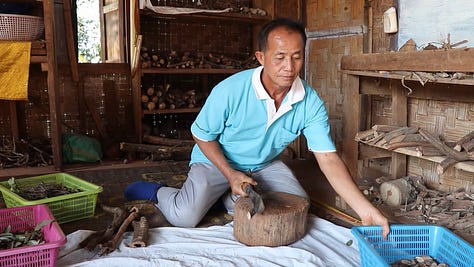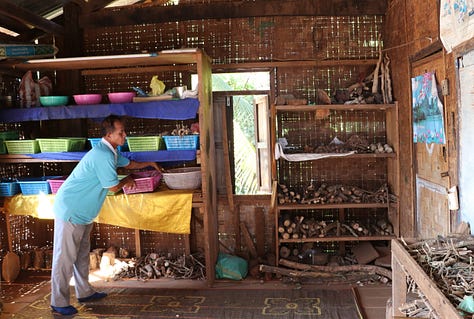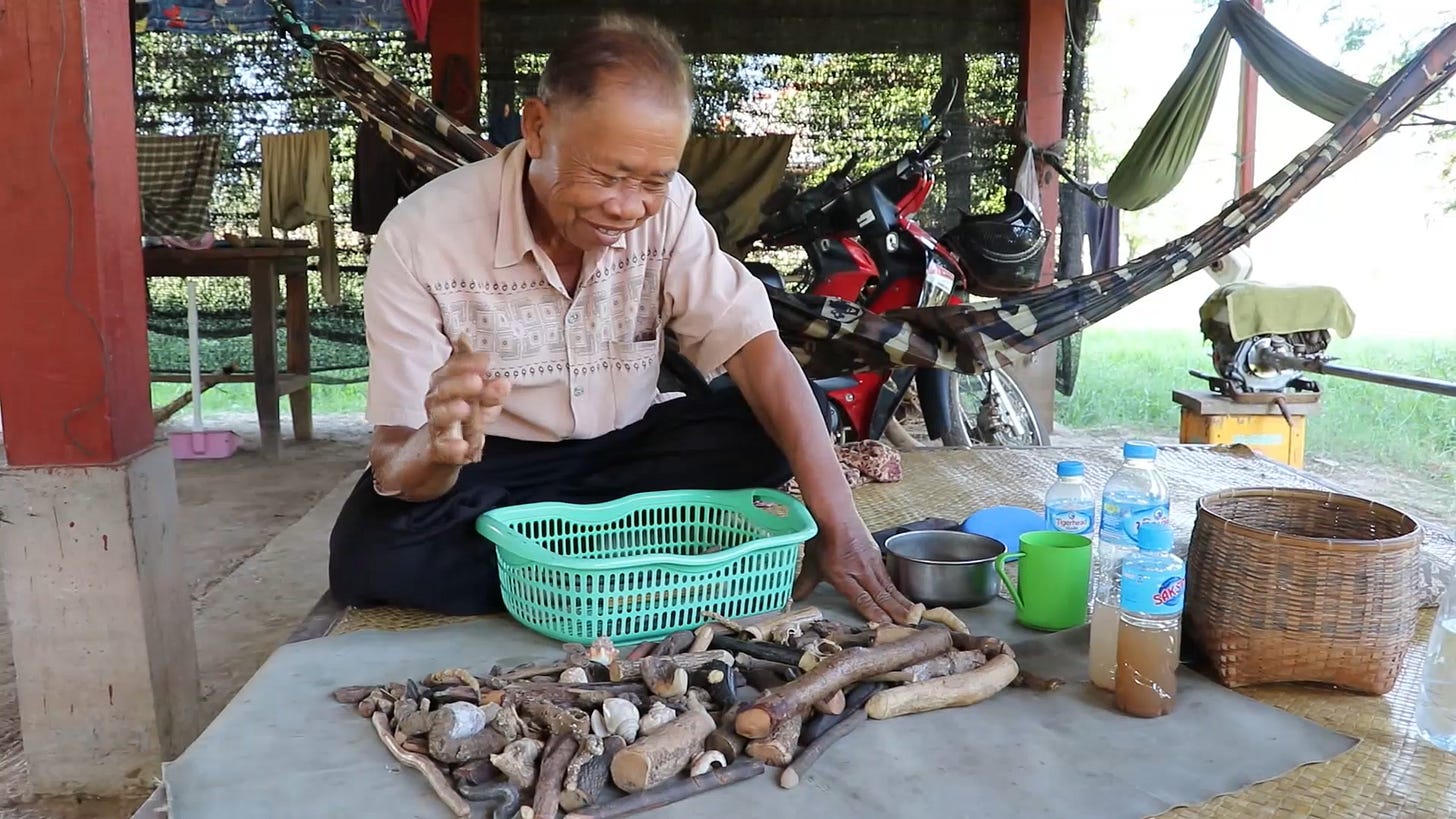Elizabeth M. Elliott is a medical anthropologist who has conducted long-term ethnographic fieldwork on traditional medicine in Laos and is an honorary research fellow in the Department of Anthropology, University College London. She has a background in Chinese medicine and recently completed a postdoctoral fellowship at the Asia Research Institute, National University of Singapore. Currently, she works as an applied anthropologist in Laos and the Western Pacific region, developing approaches to community engagement for health and socioculturally informed public health design and implementation.
The twenty-minute film Traditional Medicine in Southern Laos: A Documentary tells the stories of traditional medicine practitioners in the lowlands of Champasak Province in the far south of Laos, mainly through their own words. It features the places and people where I conducted ethnographic fieldwork during 2015–16 as part of my PhD in anthropology.[1] Since then, I have regularly visited, shooting this video footage in 2019 and eventually completing the documentary in 2023.
The three elderly men featured in the film are at the center of both the research and the film—as teachers, guides, and collaborators. While staying in their homes or the nearby village or health facility, I learned about their medical practices, recorded herbal prescriptions, collected plants during trips to the forest and in their gardens, observed them create medicines, interact with patients, and conduct rituals—and had long talks about their approach to work and life.
All are from the same generation, born before the revolution when Laos was still in the process of gaining independence from French colonial rule. Po Nueang and Ajan Vilaysack[2] describe themselves as traditional healers (mo ya phuen mueang), while Dr. Outhai is a retired medical doctor who previously managed the small traditional medicine department in the provincial hospital. The film highlights the similarities and differences in how they approach and think about traditional medicine and examines several intersecting issues through their words and practices. These include the role of traditional medicine for people seeking care, the various methods of creating medicines, formulating treatments and transmitting knowledge, approaches to medicinal plant conservation, the incorporation of magical or spiritual principles into treatment, and the urgent need for more research and documentation.
The first scene, shot at the home of Po Nueang, features a young girl who is receiving treatment for a sprained ankle and has also taken medicine for diarrhea. Po Nueang explains that the girl and her mother had traveled from several villages away and had already tried going to the hospital to receive injections and intravenous fluids (popular forms of allopathic medicine). However, it had not helped, so she had come to consult him. This story is representative of the often complex treatment-seeking routes taken by people and their families to deal with illness, where they may use multiple medical modalities to deal with uncertainty.[3]
Indeed, although traditional medicine has long been used as primary healthcare for simple ailments in Laos, it is now more commonly turned to in cases of chronic illness. Later in the film, Ajan Vilaysack describes his journey as a traditional medicine practitioner, explaining that “in the past, we didn’t have enough medicine or doctors—people lived in the forest and had to help themselves.” But these days, he mainly sees patients with illnesses such as liver disease (a common problem due to high rates of hepatitis and alcohol and raw pork consumption), thyroid, digestive and skin disorders, weakness, and paralysis. He argues that he can treat these conditions more effectively and cheaply than the hospital, which sometimes even sends him patients.



While healthcare integration is government policy, this shows how, in reality, integration still happens primarily at an individual, informal level. In Laos, traditional medicine was, as in neighboring revolutionary nations, promoted as an inexpensive, low-tech, and culturally appropriate medicine.[4] In the context of an under-resourced state biomedical system and given the weak influence of colonial healthcare, there was perhaps less impetus to create a national medicine, and so locally practiced medical forms in Laos have undergone little transformation or standardization, with no centralized knowledge source and few official treatment facilities or training courses.[5] In the far south of Laos, traditional medicine may incorporate Tai, Buddhist, Ayurvedic, Khmer, and even Chinese influences.[6] Southern medical practices are closely linked to those in culturally similar areas of northeastern Thailand and northern Cambodia.[7]
These influences are shown in the healers’ use of medicines. The combination of plant parts shown by Po Nueang, including roots, woods, barks, and other woody parts, together with some shells and animal horns, make up the ingredients of ya fon, a common medical practice of southern Laos that may be linked to ancient Khmer influence.[8] This is a technique in which a root, bark, mineral or animal product is ground against a smooth stone (hin sa) into cool water, creating a thick brown liquid that is drunk without boiling. As Po Nueang describes, it is considered a cooling medicine and is thus especially useful for fever, an ever-present condition in the heat of the southern lowlands. He demonstrates how he combines these medicines into recipes for different symptom patterns, including fever types such as chronic intermittent fever (khai sam huea), shivering cold fever leading to convulsions (khai nao san), fevers with gastrointestinal issues such as vomiting and diarrhea, those described as malaria that descends to the intestines (khai nyung long lamsai), and fever with yellow skin (khai piu lueang nang lueang). Po Nueang describes these as being forms of “the disease we now call malaria,” showing how he incorporates both traditional and biomedical explanations of disease and reflecting the variable symptom patterns of malaria that have been endemic during his lifespan, including when he was a military health worker in the 1970s.[9]
Collecting and formulating personalized prescriptions is crucial to treating illness successfully. However, while healers may follow similar principles, Lao traditional medicine knowledge is highly heterogeneous; even the oldest textual sources, such as palm-leaf manuscripts (bailan), contain discrete sets of information.[10] Po Nueang shows a book of herbal recipes (tamla) that belonged to one of his teachers and describes the learning process. Traditionally, this involves apprenticing to one or more older healers and learning certain spiritual practices to maximize the efficacy of the medicine. Ajan Vilaysack explains, “This is our secret—we use medicine and also magic to treat patients.” He demonstrates the technique of blowing (pao) to treat a man with a headache, who describes the effect afterward as “I feel cool, and I have more strength.” When blowing, the healer also mouths a healing mantra (mon).[11] In the southern lowlands, these incantations are usually spoken in Pali and, if written, inscribed in tham script. Still, they may also include Sanskrit, Khmer, and Lao words, reflecting the multidimensional origins of healing power and the layered religious history of the south of Laos, including the expansion of the Khmer empire and the relatively late arrival of Theravada Buddhism and its absorption of Hindu/Brahmanical and indigenous spiritual practices.[12]
Another distinguishing characteristic of traditional medicine in Laos is its reliance on wild harvested plant materials. Laos is highly diverse, with an estimated 8000–11,000 plant species, of which ethnobotanical studies have identified a significant number showing promising actions against disease[13] and with no previous medicinal uses recorded.[14] While Po Nueang uses mainly small pieces of roots or bark to make ya fon, Ajan Vilaysack’s medicine store contains large quantities of plant materials used for making decoctions or steam sauna, some of which he has harvested in high altitude areas; an apprentice healer “must love to go to the forest,” but it is not easy. He explains that it is very important for this medicine to be used when fresh (no more than a month old) for maximum potency, which presents a challenge because of the difficulties involved in sourcing materials. However, while walking around his land, he also observes that “everything here is a medicine,” pointing out the many uses of each herb, demonstrating how using plants as medicine is also flexible and circumstantial. This ability to recognize plants is the first step in learning traditional medicine. Po Nueang says, “If I have an apprentice, I must take him to dig up the plants first; he must collect and sort all kinds of plants.”
Traditional principles prohibit the overexploitation of plants; as Po Nueang explains, it is very important never to cut the main root so the tree does not die and can continue growing—and based on astrological principles, only one part of the plant can be harvested at a time. This approach is related to a wider “grammar of healing”[15] in which astrology is applied to diagnosis and treatment, and an ethical framework based on local cosmologies that governs how the healers interact with patients and medicines. Ajan Vilaysack says, “You must avoid destroying or selling plants without a good reason.” This refers to the rule that the healers cannot directly charge money for their services and must rely on donations given according to Buddhist principles, in comparison to medicine sellers (mo khai ya), who they regard as inferior, and non-Buddhist practitioners, who are not subject to the same restrictions.[16] The healers explain that adherence to these rules is essential for their medicine to be effective and for them to practice safely.
However, factors outside the healers’ control, such as deforestation and illegal exports, have led to a loss of plant biodiversity, a matter of great concern for them as it is becoming increasingly difficult to find the materials they need. Dr. Outhai recommends creating medicinal plant gardens and teaching students how to cultivate and use them. Some conservation efforts are in place; the Institute of Traditional Medicine oversees a network of medicinal plant preserves across the country, although lack of funding and protection makes these difficult to maintain.[17] Ajan Vilaysack has dedicated part of his land to cultivating medicinal plants, but the difficulty of ensuring water sources limits it. He has also created a small house for people with chronic illnesses to stay free of charge. Despite being in high demand by his patients, he also farms rice, coffee, and cassava with his family and has responsibilities as the village head; like most healers, he cannot depend on practicing traditional medicine to make a living.[18]
These combined challenges mean that transmission of medicinal knowledge through apprenticeship is now very low, and as these are likely the last generation of traditional healers in Laos, new forms of learning and practice will need to emerge for the future. Dr. Outhai describes his education on medicinal plants during his time at medical college “using books and a system,” which he says is a more sustainable learning method than the long process of memorization required by apprentice healers. Lao government institutions such as the Institute of Traditional Medicine and the Faculty of Pharmacy are making efforts to research, document, and create training programs, but there is much more to be done. These institutionalizing processes will inevitably alter the forms in which Lao medicine is taught and practiced; for example, the influence of staff trained in China, Thailand, or Vietnam and the emphasis on pharmaceutical evaluation and production. However, perhaps contrary to stories of resistance against state power, the healers are not against government regulation but instead frequently express the desire for their medicine and work to be recognized and documented.[19] Ajan Vilaysack advocates for a scientific approach to discover the full potential of Lao medicine; “I would like Lao medicine to be recognized internationally and researched so that we know what each part of the plant is good for . . . how many diseases can one tree treat?” He concludes with his hopes for the future: “This is my idea of how to preserve medicines for the rest of my life.”

Bibliography
Alvesson, Helle M., Magnus Lindelow, Bouasavanh Khanthaphat, and Lucie Laflamme. 2013. “Coping with Uncertainty during Healthcare-Seeking in Lao PDR.” BMC International Health and Human Rights 13, no. 1: 28. https://doi.org/10.1186/1472-698X-13-28.
Brun, Viggo, and Trond Schumacher. 1994. Traditional Herbal Medicine in Northern Thailand. Bangkok: White Lotus.
Coderey, Céline. 2017. “The Buddhist Grammar of Healing: Building Efficacy in the Pluralistic Therapeutic Context of Rakhine, Myanmar.” Asian Medicine 12, nos. 1–2: 233–64. https://doi.org/10.1163/15734218-12341394.
Dubost, Jean Marc, Chiobouaphong Phakeovilay, Chithdavone Her, Audrey Bochaton, Elizabeth Elliott, Eric Deharo, Mouachan Xayvue, Somsanith Bouamanivong, and Geneviève Bourdy. 2019. “Hmong Herbal Medicine and Herbalists in Lao PDR: Pharmacopeia and Knowledge Transmission.” Journal of Ethnobiology and Ethnomedicine 15, no. 1: 27. https://doi.org/10.1186/s13002-019-0307-2.
Elkington, Bethany G., Kongmany Sydara, John F. Hartmann, Bounhong Southavong, and D. Doel Soejarto. 2013. “Folk Epidemiology Recorded in Palm Leaf Manuscripts of Laos.” Journal of Lao Studies 3, no. 1: 1–14.
Elliott, Elizabeth M. 2021. “Potent Plants, Cool Hearts: A Landscape of Healing in Laos.” PhD thesis, University College London, UK.
Elliott, Elizabeth M. 2024. “Protecting the Body, Living the Good Life: Negotiating Health in Rural Lowland Laos.” In “The Good Life in Late Socialist Asia: Aspirations, Politics And Possibilities,” edited by Minh T. N. Nguyen, Phill Wilcox, and Jake Lin. Special issue, positions: asia critique 32, no. 1: 151–70.
Elliott, Elizabeth, François Chassagne, Agnès Aubouy, Eric Deharo, Outhay Souvanasy, Phaiboun Sythamala, Kongmany Sydara, et al. 2020. “Forest Fevers: Traditional Treatment of Malaria in the Southern Lowlands of Laos.” Journal of Ethnopharmacology 249 (March): 112–87. https://doi.org/10.1016/j.jep.2019.112187.
Finot, Louis. 1917. “Recherches sur la littérature laotienne.” Bulletin de l’École française d’Extrême-Orient 17, no. 1: 1–218. https://doi.org/10.3406/befeo.1917.5323.
Grabowsky, Volker. 2007. “Buddhism, Power, and Political Order in Pre-Twentieth Century Laos.” In Buddhism, Power and Political Order, edited by Ian Harris, 121–42. London: Routledge.
Libman, Amey, S. Bouamanivong, B. Southavong, K. Sydara, and Djaja Djendoel Soejarto. 2006. “Medicinal Plants: An Important Asset to Health Care in a Region of Central Laos.” Journal of Ethnopharmacology 106, no. 3: 303–11. https://doi.org/10.1016/j.jep.2005.11.034.
Monnais, Laurence, C. Michele Thompson, and Ayo Wahlberg. 2011. Southern Medicine for Southern People: Vietnamese Medicine in the Making. Newcastle upon Tyne: Cambridge Scholars Publishing.
Pottier, Richard. 2007. Yû dî mî hèng. Etre bien avoir de la force : essai sur les pratiques thérapeutiques lao. Monographies 192. Paris: Ecole française d’Extrême Orient.
Salguero, C. Pierce. 2016. Traditional Thai Medicine: Buddhism, Animism, Yoga, Ayurveda. 2nd rev. ed. Bangkok: White Lotus Press.
Soejarto, Djaja Djendoel, C. Gyllenhaal, M. R. Kadushin, B. Southavong, K. Sydara, S. Bouamanivong, M. Xaiveu, et al. 2012. “An Ethnobotanical Survey of Medicinal Plants of Laos toward the Discovery of Bioactive Compounds as Potential Candidates for Pharmaceutical Development.” Pharmaceutical Biology 50, no. 1: 42–60. https://doi.org/10.3109/13880209.2011.619700.
Soejarto, Djaja Djendoel, Kongmany Sydara, Bethany G. Elkington, Bounleuane Douangdeuane, Onevilay Souliya, and Mouachan Xayvue. 2023. “Conservation of Medicinal Plants of Laos.” In Medicinal Plants of Laos, edited by Djaja Djendoel Soejarto, Bethany G. Elkington, and Kongmany Sydara, 52–71. Boca Raton: CRC Press.
Sweet, Kathryn Dawn. 2015. “Limited Doses: Health and Development in Laos, 1893–2000.” PhD thesis, National University of Singapore.
Thompson, C. Michele. 2015. Vietnamese Traditional Medicine: A Social History. Singapore: National University of Singapore Press.
Vidal, Jules. 1958. “La thérapeutique par les plantes au Laos.” Journal d’agriculture et de Botanique Appliquée 5, no. 10: 601–16.
Acknowledgments
The author would like to acknowledge the assistance of the Faculty of Pharmacy at the University of Health Sciences, the Institute of Traditional Medicine, and Champasak Regional Hospital for administrative support during fieldwork. The Asia Research Institute of the National University of Singapore provided financial support to edit the documentary, and the Institut de Recherche pour le Développement in Laos provided videomaking equipment. This documentary was funded by the Global Traditional Medicine Grant (Award 73578).
[1] Elliott 2021.
[2] Po and Ajan are titles meaning “Father” and “Teacher/Scholar,” respectively.
[3] Alvesson et al. 2013.
[4] Monnais, Thompson, and Wahlberg 2011; Thompson 2015.
[5] Sweet 2015.
[6] Salguero 2016.
[7] Brun and Schumacher 1994.
[8] Vidal 1958.
[9] An analysis of the plants used in these recipes showed a high use correlation with species used cross-culturally to treat malaria, several of which have shown promising results in pharmacological studies such as Amorphophallus paeniifolius (Dennst.) Nicolson and Alocasia macrorrhizos (L.) G. Don. See Elliott et al. 2020.
[10] Elkington et al. 2013; Finot 1917.
[11] Pottier 2007.
[12] Grabowsky 2007.
[13] Soejarto et al. 2012.
[14] Libman et al. 2006.
[15] Coderey 2017.
[16] For example, ethnically Hmong medicine sellers (Dubost et al. 2019).
[17] Soejarto et al. 2023.
[18] Elliott 2024.
[19] This is likely also to reflect their status as Buddhist, lowland, male practitioners; this may be different for other healers from non-Buddhist minority groups.
